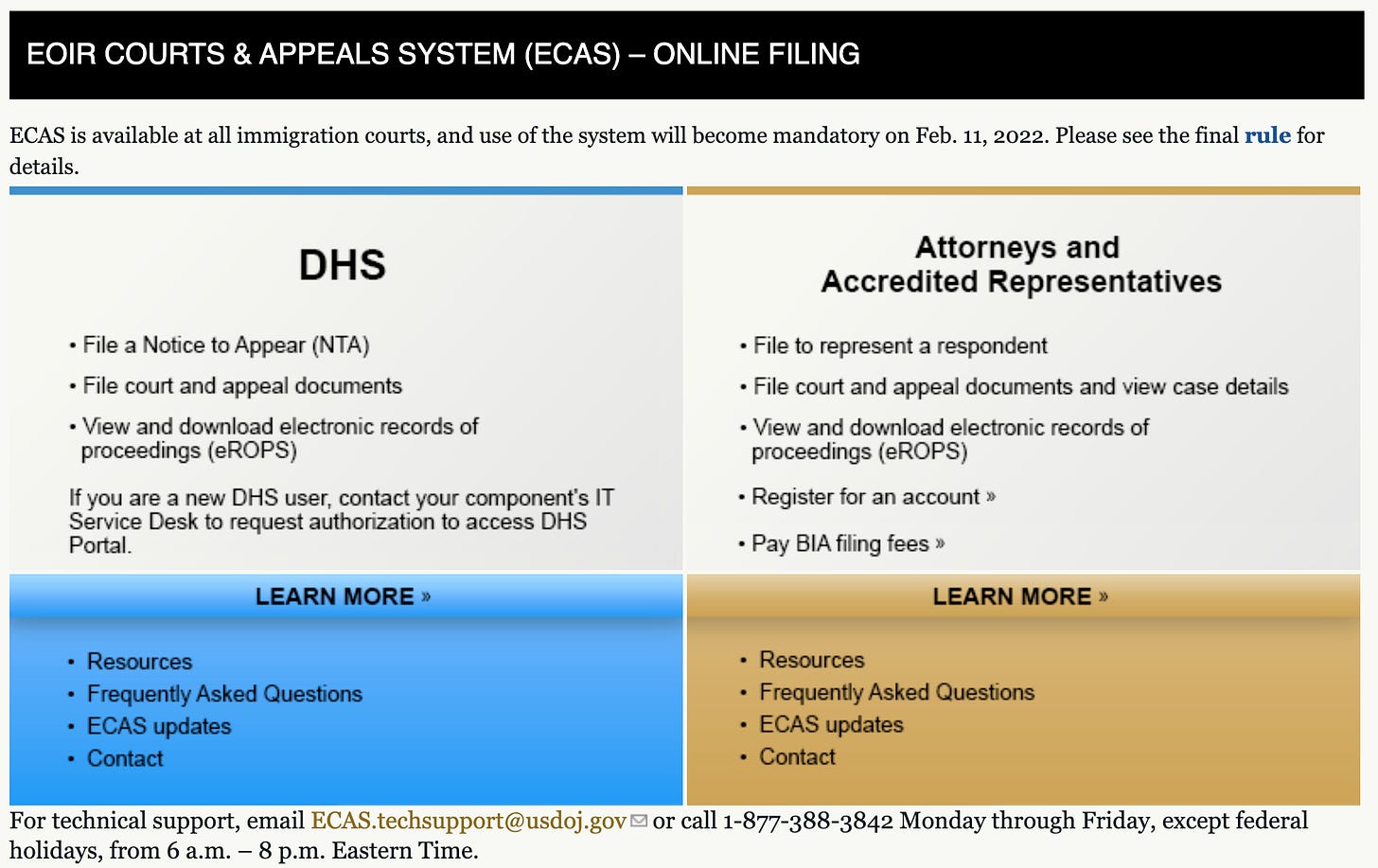Friday Roundup: The Border Patrol’s Robot Dogs, Immigration Courts are Going Digital (and Independent?), Title 42 Remains, and More
This week was packed with immigration news, but I’m going to pull out just a few stories to share.
You may notice a theme here: lots of topics about the digitization of the state. It’s no accident.
Over the past month, I’ve been looking at the emerging areas of overlap between technology, immigration enforcement, and the digitization of the courts, broadly speaking, and thinking about what it means to live in a world where you can be charged by police on your smartphone, appear in court online from your kitchen table, and then be incarcerated by GPS monitor inside your home.
And that’s just what can be done today. We also have to consider how policing may change inside the “Metaverse”.
The relationship between law and technology is shifting under our feet.
Contents
Border Patrol Getting Closer to Robot Dogs
New Legislative Proposal to Make Immigration Courts More Independent
Immigration Courts are Going Digital
CDC Recommends that Title 42 Remain in Place—Again
“Good afternoon, Ma’am. Do you know why I texted you?”
(1) Border Patrol Getting Closer to Robot Dogs
The Department of Homeland Security is getting closer to rolling out what I can only gather are immigrant hunting robot dogs created by a totally not-Skynet-sounding company called Ghost Robotics. The robot dogs—also known as Automated Ground Surveillance Vehicles (AGSVs), also known as robot dogs—appear poised to conduct monitoring and surveillance operations in rugged terrain and extreme temperatures.
The press release was noticeably (I believe intentionally) vague about precisely who or what the robot dogs were going to be monitoring. Although the DHS press release (available here) cited concerns to officer safety and criminal activity in the region, the agency said little about the fact that so many of the people the agency encounters are asylum seekers, family, and working people who are attempting to migrate to the United States.
I think there are at least two possible ways to read this (not mutually exclusive). First, we could see the actual deployment of high-tech equipment in the region, blanketing the border area in cutting edge robotic technology as a kind of experimental training ground which will lead to still larger government contracts and the expansion of this technology to other applications and new geographies.
Second, it’s also possible that this is more performative statecraft than actual workable tech. One could imagine the mutually-beneficial relationship that arises when private companies can show off their technology with government agencies and government agencies can project the perception of futuristic surveillance technology even though their real capabilities may be far more limited.
(2) Immigration Courts are Going Digital
On February 11, new court filings must be filed digitally through the EOIR’s new Courts & Appeals System or ECAS. The immigration courts have been criticized for years for relying on paper files when other federal, state, and local courts have transitioned to largely digital filings.
This is very good news. At least theoretically. The EOIR has attempted to roll out other digital tools recently, including transitioning to an online digital FOIA interface that did not go smoothly. New users could not even create a new account for weeks for no reason. If we see even a fraction of that kind of messy rollout at a time when there are 1.6 million pending immigration cases, it could be pandemonium.
I am sure that the agency will work out the kinks over the coming months and years, and eventually digital filings will be the norm. But I worry that February will bring headaches for judges, ICE attorneys, and immigration attorneys if the system is not prepared for this transition. See the DOJ’s information on ECAS here.
(3) New Legislative Proposal to Make Immigration Courts More Independent
Four House Democrats introduced a new piece of legislation called the “Real Courts, Rule of Law Act of 2022” which would create an independent immigration court system and limit the political influence that many say currently exists because the courts are within the Department of Justice. The American Immigration Lawyers Association came out in favor of the bill. Benjamin Johnson, AILA’s executive director said, “AILA has advocated for an independent immigration court and this legislation is a long-awaited step forward in this effort.”
I wrote a longer (but still brief) explanation of the history of the immigration court’s lack of independence when the House held a hearing about the topic in January. (Click here for that post.) It is worth noting one important thing that I left out, but that has certainly come up online. A significant number of immigrant rights advocates, attorneys, and scholars have criticized the energy that is being invested in these reforms.
Some view it as “too little, too late”, while others say that independence itself does nothing to fix the underlying unjust laws. I think it’s too early to tell whether this legislation will get traction given Congress’ current deadlock. But even so, the attempt at this legislation provides a window into the political viability of more piecemeal immigration reforms, as well as exposes these reforms to new (or at least renewed) critiques.
A copy of the official legislation can be downloaded here.
(4) CDC Recommends that Title 42 Remain in Place—Again
The Center for Disease Control (CDC) recommended yesterday that Title 42 remain in place after its third mandatory 60-day review since August 2021. Title 42 allows border officers to expel migrants encountered at the border under public health authority.
The policy has been criticized by immigrant rights advocates as undermining the asylum process at the border for political reasons rather than public health reasons. Title 42 has now remained in place longer under the Biden administration than it had under the Trump administration. Thanks to Camilo Montoya-Galvez at CBS for reporting on this story.
A report by the American Immigration Council provides further information about the Title 42 policy. The Center for Gender and Refugee Studies has challenged the policy in court.


(5) “Good afternoon, Ma’am. Do you know why I texted you?”
Police officers in a town in Texas are piloting a program where instead of being pulled over for speeding, you could just get a text message or a notification on an app on your smartphone notifying you of your offense and sending you a ticket. Instead of the classic “Do you know why I pulled you over?” scene unfolding on the side of the road, you could get a notification on your phone instead. (Okay, but… am I going to get this notification that I’m speeding while I’m speeding? That can’t possibly be safe.)
The Trusted Driver Program is the name of the program and also the name of the private company made up of ex-law enforcement that created the program.
And let me tell you, based on their marketing materials, you’ve never seen people so happy in their whole lives as when the police are able to contact them through an app on their smartphone.
In fact, this next guy (er…same guy) is checking his phone while he’s driving, and the heading for this image says “How Trusted Driver Works”. So I guess how it works is: you drive around all day checking your phone for minor traffic citations, which I’m 1,000% certain is going to cause you to get minor traffic citations (or an actual car accident).
Joking aside, program uses very sensitive language to sell itself: “improving trust between motorists and the police”, making your interactions with police more “convenient for you”—that kind of thing.
I’ll admit, we already do something quite similar in the world of municipal parking infractions, and I can imagine arguments in favor of this program. But I think it’s also reasonable to question the privacy concerns that this kind of technology raises and, more importantly, whether this technology will actually reproduce or exacerbate uneven policing practices rather than resolve them.
As Ruha Benjamin argues, we need to be very cautious about claims that technology can resolve concerns about racial bias and policing, given how often they merely hide it or smuggle bias back in.
The program is currently being tested in Windcrest, Texas, a suburb near San Antonio. See the news story here.
THANK YOU FOR READING! 🙏🏼
If you found this information useful, help more people see it by clicking the ☼LIKE☼ ☼SHARE☼ button below.








I like robots and I like dogs but man I hate everything about these robot dogs.
As a Redirect pod listener, I bugged Stephen and Matthew for insight on what might be coming to congress for worthy bills. I am always looking for the right legislation to push my representatives on. Any spotlight you can put on it is welcomed and please feel free to flag calls to action for us struggling citizens trying to force change. Great post today. Ty